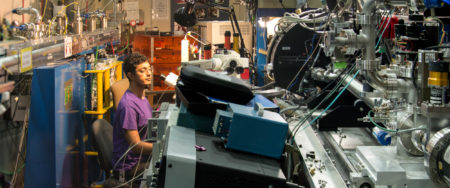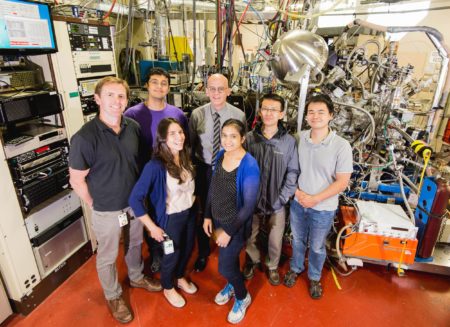by Cindy Lee
The development of an idea into a commercial product can take decades, a timeframe that allows contributions from multiple generations of scientists and requires investment in basic research. Since UC Berkeley professor Leon Chua’s 1971 prediction of a fourth circuit element (in addition to the resistor, capacitor, and inductor), research efforts in academia, industry, and national labs have combined to develop the memristor, a device that can store and process information using little to no power. Industry groups have used the ALS to evaluate materials to use as memristors and fine-tune them for applications like next-generation computer storage and computing accelerators, stretching far beyond those originally hypothesized.
In the early 2000s, Hewlett Packard Labs emeritus Senior Fellow Stan Williams began investigating the use of oxide materials in work that would lead to his becoming “the finder of memristors.” About ten years ago, his group, including John Paul Strachan and Suhas Kumar, sought out the unique instrumentation and in-house expertise at the ALS to contribute to their research. Using the scanning transmission x-ray microscopy (STXM) beamlines at the ALS, they were able to visualize atomic processes inside memristors, revealing how a memristor can remember changes even when the device loses power.

A few years into the ALS collaboration, Suhas Kumar began leading his own research team at Hewlett Packard Labs. And when the computer chips reach the market, they will incorporate work from researchers who were not yet born when Chua predicted the memristor, using technology that did not yet exist in 1971. Because the discovery process spans decades, many people have been able to contribute to the research efforts and create new uses for the advancing technology. Today, Kumar supervises Stanford graduate students Ziwen (Jerry) Wang and Stephanie Bohaichuk, who are regular users at the ALS and continue to analyze memristor materials to develop new applications.
Their work has now outgrown the original concept of memristors, and serves as an illustration of the possibilities that arise from fostering scientific curiosity. “The possibilities always evolve,” Suhas explained. “We had almost no idea that we would be using these devices, not just for the original motivation, to store information, but also to process that information.”
About three years ago, discoveries at the ALS gave the Hewlett Packard team the ingredients to very accurately predict what memristors could do. From those results, they have begun building memristor-based computer chip prototypes. The group also created the first nanoelectronic device (a new type of memristor) that operates in a non-deterministic way, an important step in developing systems that can perform brain-like computations more efficiently than any of today’s digital computers. These innovations are an important part of advancing Hewlett Packard Enterprise’s memory-driven computing architecture and are a reminder that both technological and commercial successes depend on a healthy investment in fundamental research.

Kumar credits the ALS for making these innovations possible. “We need a synchrotron for measurements that we cannot take in our labs for technical reasons, including intensity of the radiation,” he said. “The ALS has been the most ideal place for us to do this because it has a combination of different tools that does not exist anywhere else.”
User facilities at national labs provide a gathering place for ideas and expertise, and by building relationships with industry partners like Hewlett Packard Labs, the ALS has contributed to both the advancement of knowledge and the development of commercial products. “We’re here to get people together and build teams,” ALS Director Steve Kevan said. “We want to provide the tools to make progress.”
The Hewlett Packard Labs users worked closely with ALS scientists David Kilcoyne, Tolek Tyliszczak, David Shapiro, Hendrik Ohldag, and Eli Rotenberg. Together, they developed a toolkit for quickly switching between operating a sample and probing the sample, and they have made the toolkit available to other researchers who have come to work at the ALS. Kumar noted, “One of the main reasons why we use public [non-proprietary] time at the ALS is because, as a policy, we want the science that comes out of it to be of public benefit.” Accordingly, Hewlett Packard Labs publishes peer-reviewed papers in the open scientific literature, and students who work with them publish their Ph.D. dissertations as well. Because they have released their results, other groups have been inspired by the work and approached the ALS to harness memristor technology for their own needs.
Many different processes have the potential to benefit from memristors, which are crucial in minimizing energy costs despite ever increasing computational demands. The seed of an academic idea, fostered by industry, and advanced by tools and expertise at a national user facility, has paved the way for technological advances that are only beginning to be envisioned.
